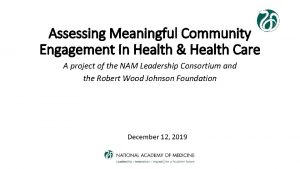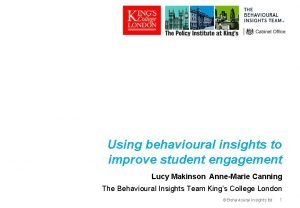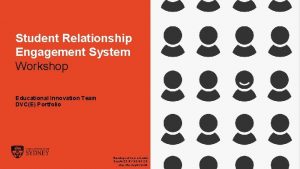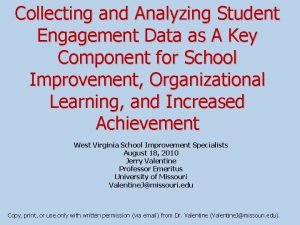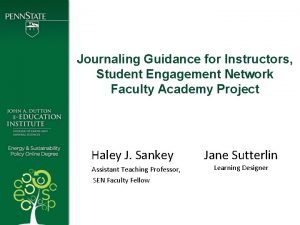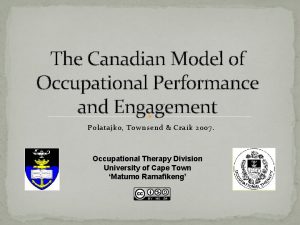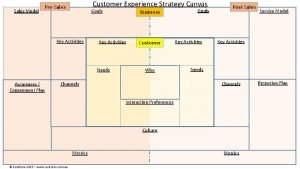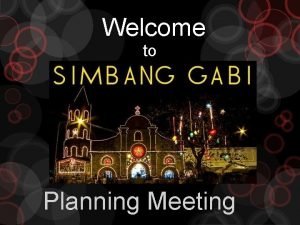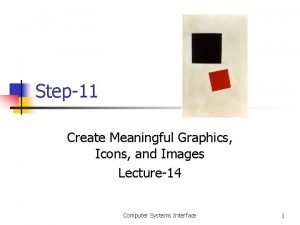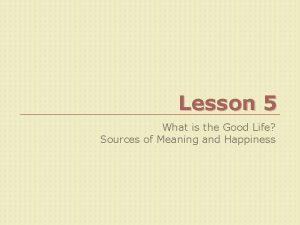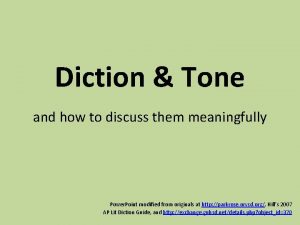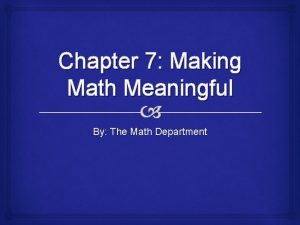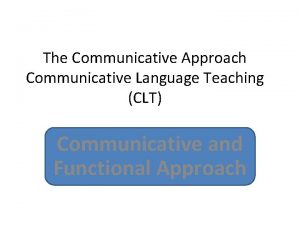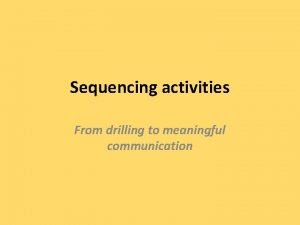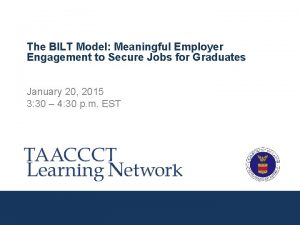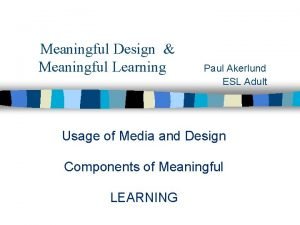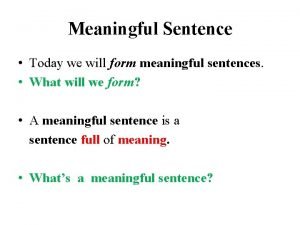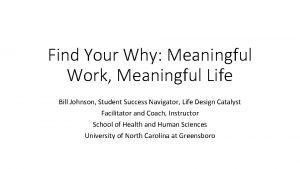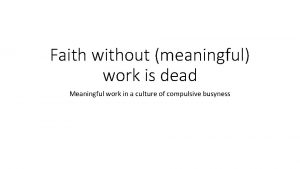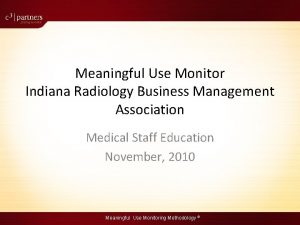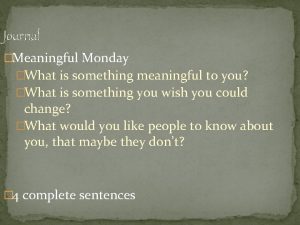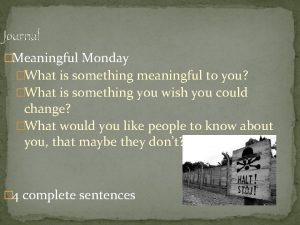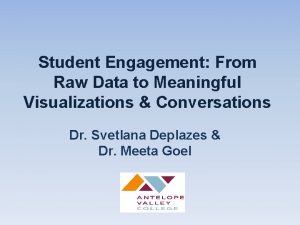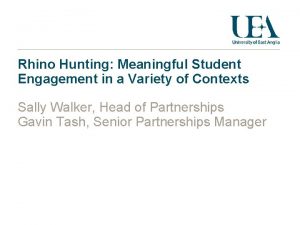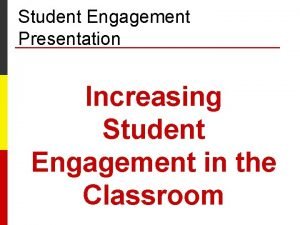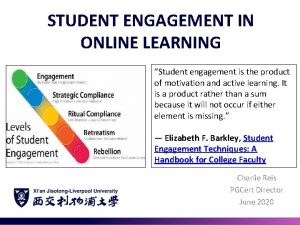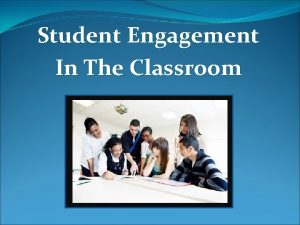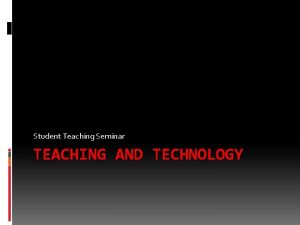A Model for Meaningful Student Engagement Student Teaching






















- Slides: 22

A Model for Meaningful Student Engagement: Student Teaching and Learning Consultants Students as Producers, Lincoln University, 26 -27 th June 2013 Kathrine Jensen, Dr Liz Bennett, Dawn Bagnall

Workshop overview First Activity: • Different methods for student engagements. • Explore models of participation/engagement. Second Activity: • Evaluating activity 1 in relation to models. Third Activity: • Characteristics of the methods. Present our Student as Teaching and Learning Consultants model.

Group - Activity 1 • How do you engage students and get their feedback on teaching and learning? • See cards – any others? • Which are most effective in terms of their impact on teaching and learning and why?

Arnstein’s ladder of citizen participation

Students in control Partnership - a negotiated curriculum Student control of some areas of choice Students control of prescribed areas Wide choice from prescribed choices Limited choice from prescribed choices Participation claimed, tutor in control Dictated curriculum – no interaction Students control decision-making and have substantial influence Students have some choice and influence Tutors control decision -making informed by student feedback Tutors control decision -making Students increasingly active in participation Ladder of student participation in curriculum design

‘LADDER’ OF PARTICIPATION Type of participation Type of involvement Level of engagement Learner control Learners initiate agendas and are given responsibility and power for management of issues and to bring about change. Power is delegated to learners and they are active in designing their education Learner empowerment Delegated power Staff still inform agenda for action but learners are given responsibility for managing aspects or all of any initiatives or programmes that result. Decisions are shared with staff Learner empowerment Partnership Placation Learners are consulted and informed in decision making processes. Outcomes are the result of negotiations between staff and learners Learners are consulted and informed. Learners’ views are listened to in order to inform the decision making process but this does not guarantee any changes learners may have wanted Tokenism Consultation Learners are kept fully informed and encouraged to express their opinions but have little or no impact on outcomes Tokenism Informing Learners are merely informed of action and changes but their views are not actively sought Non participation Decoration Learners may be indirectly involved in decisions or ‘campaigns’ but they are not fully aware of their rights, their possible involvement or how decisions might affect them Non participation Learners are directed by staff and tend not to be informed of the issues. Learners may be asked to ‘rubberstamp’ decisions already taken by staff Non participation Manipulation

Activity 2 Types of engagement – ladder participation • Which level of the ladder are the types of activity? • Try to place the types of engagement card on a level of the ladder

Activity 3 - diamond 9 What are the characteristics of student feedback that will lead to positive impact on t&l? You may wish to replace a card with one of your own statements Most Important Least Important ?

Student as partners model • Joint Students’ Union and Teaching and Learning Institute project. • Funded by Higher Education Academy Individual Teaching Development Grant. • One year project (Aug 2012 – Aug 2013). • Staff volunteer to participate. • Students recruited by SU, trained and paid. • Inspired by Dr Crawford’s SCOT Project.

Project aims • to promote authentic student engagement in the enhancement of teaching and learning (and explore the nature and construct of inspirational teaching). • to create opportunities for student and staff to engage in reflection and dialogue around teaching and learning approaches. • offer academic staff a qualified student perspective (at points of need) that goes beyond the typical end of module evaluation response or NSS survey.

Consultation process • Lecturer contacts project coordinator (PC) with request • Project coordinator contacts student consultants (SC) with task • SC contacts lecturer to set up meeting • SC carries out task • SC arranges feed back meeting with lecturer • SC share reflections via online platform to support SCs • Student sends evaluation of consultation to PC • Lecturer sends of consultation to PC

• 11 student consultants. • Gained skills/confidence. • Invented a new role for students. • “Nice to feel on par with a lecturer and work ‘with them’ rather than ‘for’ or ‘against’ them”.

Staff Requests • 6: observation of session/activity including focus group or dialogue with students • 2: evaluate course materials on the University virtual learning environment • 6: observation of sessions (lectures/seminars) for general student perspective/experience • 1: assessment of delivery of a subject • 1: interview students for feedback on lecture, practical teaching methods and module in general

• 16 academic staff (11 completed evaluation). • Professional students. • Positive, useful feedback. • Recommend to colleagues. • “Highly recommended – I just wish there were more feedback mechanisms like this that would allow some sort of feedback and evaluation for every session”.

The Partnership ethos • “Working with the student consultants was a real delight; they were professional and polite throughout. They also provided some really useful feedback in a very objective and nonjudgmental way; nowhere near as scary as one might first imagine!” • “The opportunity to engage a student perspective is refreshing and challenging. I think this is valuable. ” • “It was good to be able to speak in a relaxed and informal way about the delivery of the course. ”

Thoughts on feedback - authentic “I thought it was amazing. We looked at what students wanted from feedback as opposed to what I want them to learn. ” “I thought the feedback was incredibly useful. It had both positive and negative points and he had clearly thought about the activity and its use to students. ”

Thoughts on feedback - process “The feedback received provided some very useful insights. The feedback was delivered in written and verbal form, written first followed by a face-to-face meeting. This was very useful, since it allowed time for reflection …before being given further comments and being able to ask for clarification on a couple of points. ”

Impact • Student consultants as internal ‘experts’ available to get involved • Building relationships within organisation

Impact on Teaching and Learning • “I will be much more careful in how I give my feedback, and in particular be sure that feedback fits with the rubrics rather than to the learning outcomes…” • “We will continue asking for a different lecture room for next year. Otherwise, feedback was very positive, which helped reassure us we did certain things right, which is not always obvious”

Reflections • Face to face feedback = conversations. • Developing impact evaluation. • Encourage staff to market at course committee level. • Who engages with the scheme? • Scope and scale of the scheme.

More information • Project webpage: http: //bit. ly/Zgc 2 WB • Contact: k. jensen@hud. ac. uk • Twitter: @kshjensen • Blogposts tagged with HEASTLC: http: //bit. ly/13 l 205 S

Image References • Engagement: photo by Mark Curry, University of Huddersfield, All rights reserved. • Splash photo by Carola http: //www. flickr. com/photos/carol ags/ • All other graphics are clipart.
 Meaningful engagement definition
Meaningful engagement definition Student engagement insight
Student engagement insight Usyd sres
Usyd sres Australasian survey of student engagement
Australasian survey of student engagement Student engagement data collection
Student engagement data collection Student engagement presentation
Student engagement presentation Student engagement network
Student engagement network Purposes of micro teaching
Purposes of micro teaching How to become a microsoft partner
How to become a microsoft partner Mezzo system definition
Mezzo system definition Canadian model of occupational performance and engagement
Canadian model of occupational performance and engagement Hoerbiger intranet
Hoerbiger intranet Sales model canvas
Sales model canvas Opening prayer for meetings
Opening prayer for meetings Meaningful icon
Meaningful icon Nothing in this world can fill the spiritual vacuum within
Nothing in this world can fill the spiritual vacuum within Meaningful work statement
Meaningful work statement Diction vs tone
Diction vs tone Making math meaningful
Making math meaningful What is meaningful reception learning
What is meaningful reception learning Picture strip story in communicative language teaching
Picture strip story in communicative language teaching Snodent
Snodent Meaningful drill
Meaningful drill
